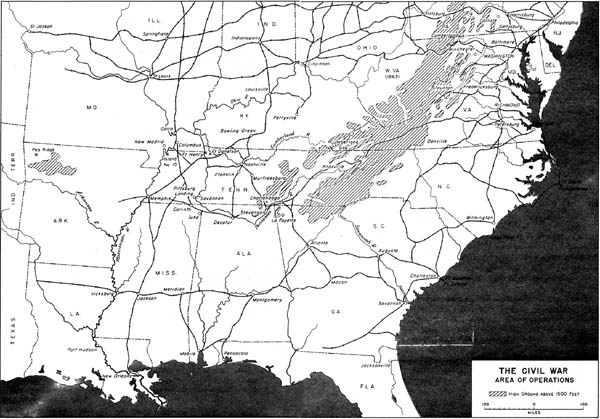|
Union |
Confederacy |
|
|---|---|---|
|
Percent of nation's population |
71% |
29% |
|
Percent of nation's railroads |
71% |
29% |
|
Percent of nation's farm acreage |
65% |
35% |
|
Percent of nation's manufacturing workers |
92% |
8% |
|
Percent of nation's manufacturing output |
92% |
8% |
|
Number of factories |
110,000 |
18,000 |
|
Railroad mileage |
22,000 |
9,000 |
As North and South prepared for battle, clearly the preponderance of productive capacity, manpower, and agricultural potential lay on the side of the North. Its crops were worth more annually than those of the South, which had concentrated on growing cotton, tobacco, and rice. Between February and May 1861 the Confederate authorities missed the opportunity of shipping baled cotton to England and drawing bills against it for the purchase of arms. In seapower, railroads, material wealth, and industrial capacity to produce iron and munitions the North was vastly superior to the South. This disparity became even more pronounced as the ever-tightening blockade gradually cut off the Confederacy from foreign imports. The North had more mules and horses, a logistical advantage of great importance since supplies had to be carried to the troops from rail and river heads.
According to the census of 1860 the population of the United States numbered 31,443,321 persons. Approximately 23,000,000 of them were in the twenty-two northern states and 9,000,000 in the eleven states that later seceded. Of the latter total, 3,500,000 were enslaved people. The size of the opposing armies would reflect this disparity. At one time or another about 2,100,000 men would serve in the northern armies, while some 800,000 to 900,000 men would serve the South. Peak strength of the two forces would be about 1,000,000 and 600,000, respectively.
Yet not all the advantages lay with the North. The South possessed good interior lines of communications, and its 3,550-mile coast line, embracing 189 harbors and navigable river mouths, was most difficult to blockade effectively. Possessors of a rich military record in wars against the British, Spanish, Mexicans, and American Indians, the southerners initially managed to form redoubtable cavalry units more easily than the North and used them with considerable skill against the invading infantry. As the war moved along, Union generals generally demonstrated greater military prowess than Confederate generals, like Braxton Bragg. Despite this, the battles of the Civil War were among the bloodiest in modern history.
Jefferson Davis hoped that the sympathy or even intervention of European powers might more than compensate for the Confederacy's lack of material resources and unreliable generals. This hope, largely illusory from the start, became less and less likely of realization with the emancipation of enslaved people, with every Union victory, and with the increasing effectiveness of the blockade.
Militarily, the South's greatest advantage over the North was simply the fact that if not attacked it could win by doing nothing. To restore the Union the Federal forces would have to conquer the Confederacy. Thus the arena of action lay below the strategic line of the Potomac and Ohio Rivers. Here geography divided the theater of war into three interrelated theaters of operations. The eastern theater lay between the Atlantic Ocean and the Appalachian Mountains; the western theater embraced the area from the Appalachians to the Mississippi; and the trans-Mississippi theater ran westward to the Pacific Ocean.
In the east, the strategic triangle of northern Virginia shielded invasion routes. Its apex aimed arrowlike at the Federal capital; the Potomac River and the lower Chesapeake Bay formed its right leg; its left bounded on the Blue Ridge and the adjacent Shenandoah Valley; and the base of the triangle followed the basin of the James and Appomattox Rivers, whereon stood Richmond, halfway between the bay and the valley. For three and a half years Federal commanders would be defeated on the legs and in the center of this triangle as they tried to take Richmond and defeat the Army of Northern Virginia under Lee. In three neighboring counties within this triangle more than half a million men would clash in mortal combat; more would die in these counties than in the Revolutionary War, the War of 1812, the War with Mexico, and all the Indian wars combined. To bring the Confederates out of this triangle the North would have to execute an operation aimed at breaking through the base line along the James and Appomattox Rivers.
The hammer for swinging against the anvil of Virginia came from the line of the Ohio River as Union forces moved along the invasion routes of the Green, Cumberland, Tennessee, and Mississippi Rivers. To breach the lower reaches of the Appalachians, the Federals needed the railroad centers at Nashville, Chattanooga, and Atlanta; with them they could strike northward through the Carolinas toward the line of the James. But in the spring of 1861, the anvil and hammer concept had not yet occurred to the military leaders in Washington. Only the General in Chief, Winfield Scott, had a concrete strategic proposal for waging total war. He recommended to Lincoln that time be taken to train an army of 85,000 men and that the naval blockade of the Confederacy be enforced. Then the Army was to advance down the Mississippi to divide and conquer the South. The press ridiculed the strategy, calling it the Anaconda Plan. But few leaders examined the South in terms of its military geography or concentrated on a strategy to prevail over it. Instead, most thought in terms of political boundaries and a short war that would end with the capture of Richmond.
Source Citation:
American Military History. Office of the Chief of Military History, United States Army. https://history.army.mil/books/AMH/AMH-09.htm
